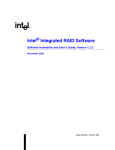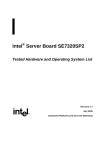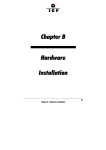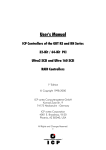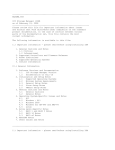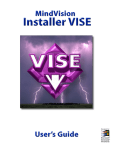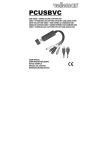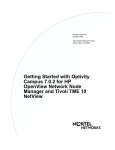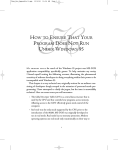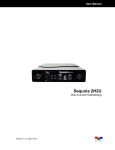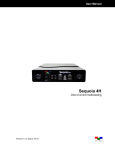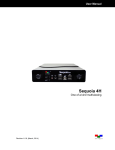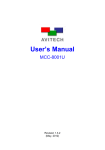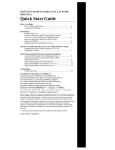Download Preliminary ICP RAID Controllers GDT8514RZ and
Transcript
ICP RAID Controllers GDT8514RZ and GDT8114RZ Single-channel Low Profile U320 RAID Controllers Hardware Installation and User’s Guide, Version 1.2.6 April 2003 Preliminary IMPORTANT NOTICE - READ BEFORE MAKING USE OF THE INFORMATION CONTAINED HEREIN This information is provided “as is.” Information in this document is provided solely to enable use of ICP products. Except as provided in ICP vortex’s Terms and Conditions of sale ICP vortex and/or its suppliers assume no liability whatsoever, and ICP vortex and/or its suppliers disclaim any express or implied warranty, relating to this information including liability or warranties relating to fitness for a particular purpose, merchantability, satisfactory quality or infringement of any patent, copyright or other intellectual property right. ICP vortex and/or its suppliers assume no responsibility for any omissions or any errors which may appear in this document nor does it make a commitment to update the information contained herein. ICP vortex retains the right to make changes to this document and its products at any time, without notice. No License, express or implied, by Estoppel or otherwise, to any intellectual property rights is granted by this document. ICP products are not intended for use in medical, life saving, or life sustaining applications. Any recommended operating or test methods are correct to ICP’s reasonable knowledge at the time of writing. ICP vortex and/or its suppliers accept no liability for the implementation of these methods within the user’s environment. The user is responsible for and must satisfy itself that any use made of this information or ICP products is suitable to its needs. Any named third party suppliers are provided for information only. The hardware vendor remains solely responsible for the design, sale and functionality of its product, including any liability arising from product infringement or product warranty. ICP vortex accepts no liability for the quality of third party suppliers, and cannot guarantee that third party products are suitable or are compatible with Intel products or that third party suppliers will not change parts so that they are no longer compatible or no longer suitable. IN NO EVENT WILL ICP VORTEX AND/OR ITS SUPPLIERS BE LIABLE TO THE RECIPIENT OR USER OF THIS INFORMATION FOR ANY LOSS OF PROFITS, LOSS OF USE, BUSINESS INTERRUPTIONS, INFRINGEMENT OF ANY THIRD PARTY INTELLECTUAL PROPERTY RIGHTS, LOSS OR CORRUPTION OF DATA, INCIDENTAL, INDIRECT, SPECULATIVE, CONSEQUENTIAL, OR SPECIAL DAMAGES, HOWSOEVER ARISING AND IRRESPECTIVE OF WHETHER INTEL HAS ADVANCE NOTICE OF THE POSSIBILITY OF SUCH DAMAGES. THE LIMITATIONS AND DISCLAIMERS SET FORTH HEREIN WERE AN ESSENTIAL ELEMENT IN ICP VORTEX AGREEING TO SUPPLY THIS INFORMATION FREE OF CHARGE. THEY SHALL APPLY NOTWITHSTANDING SECTION 1.1 OF THE TERMS AND CONDITIONS OF SALE OF ICP VORTEX Hardware Installation and User’s Guide Contents 1 Getting Started 1.1 1.5 Using the User Documentation Set ............................................................................................... 5 1.1.1 Document Formats ...................................................................................................... 6 About This Guide...........................................................................................................................6 Customer Support Contact Information ......................................................................................... 6 Regulatory and Certification Information ....................................................................................... 7 1.4.1 Product Regulatory Compliance .................................................................................. 7 1.4.2 Product Safety Compliance ......................................................................................... 7 1.4.3 Product EMC Compliance ...........................................................................................7 1.4.4 Product Regulatory Compliance Markings .................................................................. 7 1.4.5 Electromagnetic Compatibility Notices ........................................................................ 7 Warnings and Cautions ................................................................................................................. 9 2 Hardware Installation 2.1 2.3 Installation Procedures ................................................................................................................11 2.1.1 Computer System Hardware Requirements ..............................................................11 2.1.2 Installing the ICP RAID Controller .............................................................................12 2.1.3 Changing Jumper Settings ........................................................................................13 Diagnostic Features ....................................................................................................................15 2.2.1 LED Indicators ...........................................................................................................16 2.2.2 Audible Alarm ............................................................................................................16 2.2.3 Beep Sequences During System Boot ......................................................................17 SCSI Termination ........................................................................................................................17 3 Hardware Specifications and Features 3.1 3.6 ICP RAID Controller Hardware Features.....................................................................................19 3.1.1 Key Features .............................................................................................................19 Operating System Support ..........................................................................................................21 Supported SCSI Technology .......................................................................................................21 3.3.1 Supported Hard Drive Technology ............................................................................21 3.3.2 Support for Non-Hard-Disk-Drive SCSI Devices (Non-Direct-Access Devices) ........23 Array Roaming Compatibility .......................................................................................................23 Optional Features ........................................................................................................................24 3.5.1 PCI Hot Plug ..............................................................................................................24 3.5.2 Configurable Disk Drive SCSI Parameters ................................................................24 3.5.3 Configurable I/O Controller SCSI Parameters ...........................................................25 RAID Controller Drive Limitations (Host, Array, Logical, and Physical).......................................25 A Flash Memory Programming A.1 A.2 A.3 A.4 About Firmware Files..................................................................................................................27 Choosing Update vs. Recover ....................................................................................................27 Setting Jumper J4.......................................................................................................................27 Updating or Recovering Firmware Using the FRUU...................................................................28 A.4.1 Creating Firmware Diskettes from the CD-ROM Autorun Menu ................................29 A.4.2 Creating Firmware Diskettes from the Bootable RAID Software Suite CD-ROM ......30 A.4.3 Running the FRUU ....................................................................................................30 1.2 1.3 1.4 2.2 3.2 3.3 3.4 3.5 Hardware Installation and User’s Guide 3 A.5 Updating Firmware Using XROM ICPCON ................................................................................ 32 Index Figures 2-1 2-2 2-3 2-4 ICP RAID Controller Component Layout .................................................................................... 12 Installing the ICP RAID Controller into a Computer System....................................................... 13 Jumper Locations and Pin Numbers .......................................................................................... 14 LED Labels and Colors............................................................................................................... 16 Tables 2-1 2-2 2-3 3-1 3-2 3-3 3-4 3-5 3-6 4 Controller Jumper Settings ......................................................................................................... 15 LED Descriptions ........................................................................................................................ 16 Beep Sequences ........................................................................................................................ 17 Hardware Architecture ................................................................................................................ 19 Environmental Specifications ..................................................................................................... 20 Supported SCSI Device Standards ............................................................................................ 22 Configurable Disk Drive SCSI Parameters ................................................................................. 24 Configurable I/O Controller SCSI Parameters ............................................................................ 25 RAID Controller Drive Maximum Limitations .............................................................................. 26 Hardware Installation and User’s Guide Getting Started Getting Started 1 Intended Audience This documentation is intended for users who are experienced in configuring computer systems with new add-in cards or have had previous experience with ICP RAID Controllers. Read and adhere to all warnings, cautions, and notices in this guide and the other documents in the user documentation set supplied with this product. 1.1 Using the User Documentation Set User documentation for this product is provided in four separate documents. Not all of them must be part of the printed documentation. You will find the following documents on the RAID software suite CD-ROM: Quick Installation Guide The Quick Installation Guide provides a high level view of installing and configuring a RAID controller. Refer to the accompanying Software Guide for more detailed information. Hardware Installation and User’s Guide The Hardware Installation and User’s Guide, or Hardware Guide, covers instructions for installing an ICP RAID controller and provides a guide to its features and specifications. For a particular ICP RAID controller, its hardware guide documents compatible RAID adapters, supported operating systems, standard features and optional features. Software Installation and User’s Guide The Software Installation and User’s Guide, or Software Guide, contains: • Quick installation of the ICP RAID controller software on a newly created bootable host drive with commonly used operating systems. • Detailed instructions covering more complex software installation scenarios for all supported operating systems. • Instructions for using the RAID Software Suite, the drivers, tools and utilities of the ICP RAID controller. The first part of the software guide provides an overview of RAID technology and its features. Next, the guide documents various installation procedures for an ICP RAID controller and the RAID Software Suite, depending on the chosen operating system configuration. The software guide then includes descriptions of the utilities, ICP RAID Console (ICPCON) and ICP RAID Navigator (ICP RAID Navigator), to facilitate the configuration of the RAID subsystem. Finally, the guide provides details of all product Hardware Installation and User’s Guide 5 Getting Started features supported by the software and firmware For further information refer to the Optional Features section of the appropriate hardware guide since not all features are applicable to all ICP RAID controllers. Clustering Guide The ICP RAID Controller Clustering Guide, or Clustering Guide, describes how to set up clustering configurations using ICP RAID Controllers and ICP RAID controller software. Information on Operating Systems, Cluster functionality, and other system details may be found in their corresponding system manuals. 1.1.1 Document Formats All documents, with the exception of the quick start guide, are provided on the CD-ROM in both PDF and HTML format: • HTML—To view online HTML documents, Click Documentation from the autorun menu or open <cdromdrive>:\docs\index.htm. • PDF—Portable Document Format (PDF) documents can be opened, viewed, and printed with Adobe* Acrobat Reader* (not provided on the CD-ROM). 1.2 About This Guide This guide contains three sections: Chapter 1, Getting Started This chapter covers how to use the different user documents in the user documentation set, customer support contact information, and regulatory and license agreements covering this product. Chapter 2, Hardware Installation This chapter contains the procedures for installing the ICP RAID controller into a computer system. Chapter 3, Hardware Specifications and Features This chapter covers all the hardware specifications associated with the ICP RAID controller and its components and any optional RAID features that are supported by the RAID Software. The software guide covers in detail all software features. 1.3 Customer Support Contact Information For product support, visit http://www.icp-vortex.com or http://www.vortex.de. 6 Hardware Installation and User’s Guide Getting Started 1.4 Regulatory and Certification Information Note: This controller is intended for use in UL Listed computers or equivalent, that have instructions detailing installation. 1.4.1 Product Regulatory Compliance The GDT8514RZ and GDT8114RZ RAID controllers, when correctly integrated per this guide, comply with the following safety and electromagnetic compatibility (EMC) regulations. 1.4.2 Product Safety Compliance • CE - Low Voltage Directive (73/23/EEC) (European Union) 1.4.3 Product EMC Compliance • FCC Part 15, Class B Emissions (USA) 1.4.4 Product Regulatory Compliance Markings The GDT8x14RZ RAID controllers are marked with the following regulatory markings: Marking Description CE mark for European Union 1.4.5 Electromagnetic Compatibility Notices 1.4.5.1 FCC Verification Statement (USA) Product Type: GDT8x14RZ This device complies with Part 15 of the FCC Rules. Operation is subject to the following two conditions: (1) This device may not cause harmful interference, and (2) this device must accept any interference received, including interference that may cause undesired operation. This equipment has been tested and found to comply with the limits for a Class B digital device, pursuant to Part 15 of the FCC Rules. These limits are designed to provide reasonable protection against harmful interference in a Hardware Installation and User’s Guide 7 Getting Started residential installation. This equipment generates, uses and can radiate radio frequency energy and, if not installed and used in accordance with the instructions, may cause harmful interference to radio communications. However, there is no guarantee that interference will not occur in a particular installation. If this equipment does cause harmful interference to radio or television reception, which can be determined by turning the equipment off and on, the user is encouraged to try to correct the interference by one or more of the following measures: -- Reorient or relocate the receiving antenna. -- Increase the separation between the equipment and receiver. -- Connect the equipment into an outlet on a circuit different from that to which the receiver is connected. -- Consult the dealer or an experienced radio/TV technician for help. If you make any modification to the equipment not expressly approved by ICP vortex, you could void your authority to operate the equipment. Any changes or modifications not expressly approved by the grantee of this device could void the user’s authority to operate the equipment. The customer is responsible for ensuring compliance of the modified product. All cables used to connect to peripherals must be shielded and grounded. Operation with cables, connected to peripherals that are not shielded and grounded may result in interference to radio and TV reception. 1.4.5.2 CE Declaration of Conformity (Europe) We, ICP vortex Corporation, declare under our sole responsibility that the product: ICP vortex GDT8x14RZ is in conformity with all applicable essential requirements necessary for CE marking, following the provisions of the European Council Directive 89/336/EEC (EMC Directive) and Council Directive 73/23/EEC (Safety/Low Voltage Directive). The product is properly CE marked demonstrating this conformity and is for distribution within all member states of the EU with no restrictions. This product follows the provisions of the European Directives 89/336/EEC and 73/23/ EEC. Dansk Dette produkt er i overensstemmelse med det europæiske direktiv 89/336/EEC & 73/23/EEC. Dutch Dit product is in navolging van de bepalingen van Europees Directief 89/336/EEC & 73/23/EEC. Suomi Tämä tuote noudattaa EU-direktiivin 89/336/EEC & 73/23/EEC määräyksiä. 8 Hardware Installation and User’s Guide Getting Started Français Ce produit est conforme aux exigences de la Directive Européenne 89/336/EEC & 73/23/EEC. Deutsch Dieses Produkt entspricht den Bestimmungen der Europäischen Richtlinie 89/ 336/EEC & 73/23/EEC. Icelandic Þessi vara stenst reglugerð Evrópska Efnahags Bandalagsins númer 89/336/ EEC & 73/23/EEC. Italiano Questo prodotto è conforme alla Direttiva Europea 89/336/EEC & 73/23/EEC. Norsk Dette produktet er i henhold til bestemmelsene i det europeiske direktivet 89/336/ EEC & 73/23/EEC. Portuguese Este produto cumpre com as normas da Diretiva Européia 89/336/EEC & 73/ 23/EEC. Español Este producto cumple con las normas del Directivo Europeo 89/336/EEC & 73/ 23/EEC. Svenska Denna produkt har tillverkats i enlighet med EG-direktiv 89/336/EEC & 73/23/ EEC. 1.5 Warnings and Cautions This guide and all associated guides in the user documentation set (the Quick Start Guide, the Hardware Guide, and the Software Guide) should be used by qualified technical personnel with experience installing and configuring PCI controllers. Read and adhere to all warnings, cautions, and notices in this guide and all the guides in the user documentation set supplied with this product. Warnings • The connection of a non-shielded equipment interface cable to this equipment will invalidate the FCC certification of this device and may cause interference levels that exceed the limits established by the FCC for this equipment. It is the responsibility of the user to obtain and use a shielded equipment interface cable with this device. If the equipment has more than one interface connector, do not leave cables connected to unused interfaces unless otherwise instructed to do so in the user manual. • Changes or modifications not expressly approved by the manufacturer could void the user's authority to operate the equipment. Cautions • Take precautions to prevent electrostatic discharge (ESD) damage before handling the ICP RAID controller. • ESD can damage controller components. Perform the described procedures in this guide only at an ESD workstation. If no such station is available, you can provide some Hardware Installation and User’s Guide 9 Getting Started ESD protection by wearing an antistatic wrist strap and attaching it to a metal part of the computer chassis. 10 Hardware Installation and User’s Guide Hardware Installation Hardware Installation 2 This chapter provides information on installing the ICP RAID controller, programming the Flash memory, setting jumpers, using the LEDs and alarms to diagnose the controller, and general SCSI termination information. 2.1 Installation Procedures Warning: Shock hazards may be present inside the computer in which this controller is being installed. Disconnect all power cords to the computer before the removal of any covers. Follow the warnings noted in your computer’s user manual before installing this board. ONLY after reinstallation of all the covers should you reconnect the power cords and power up the computer. Note: Take precautions to prevent electrostatic discharge (ESD) damage before handling the ICP RAID controller. 2.1.1 Computer System Hardware Requirements • Computer with CD-ROM drive (not attached to the ICP RAID controller) • One available 64-bit/66MHz PCI slot for optimal performance; however, the controller is backwards compatible with all 33MHz PCI expansion slots. • PCI 2.2 compliant system BIOS Hardware Installation and User’s Guide 11 Hardware Installation Figure 2-1. ICP RAID Controller Component Layout Low-profile Bracket Standard Bracket External VHDCI LVD Connector Channel A Channel A Channel A Terminators for Channel A SCSI Termination Power Jumpers (J5) Dual-channel Ultra320 SCSI Controller Channel B Channel B Channel B Internal 68-pin LVD Connector Terminators for Channel B 167 mm 167 mm IOP Mode Select Jumper (J4 ) PCI Bus Speed Intel® 80303® I/O Processor Power Status DMA Mode Ch-B activity Ch-A activity P P66 66MHz = On 33MHz =Off A B T S Alarm SCSI Bus Termination Jumpers (J1) 64-bit / 66MHz, Universally keyed, 3.3 and 5 volt, PCI Interface 128MB ECC SDRAM Data Cache 2.1.2 56 mm 56 mm Front View Back View Installing the ICP RAID Controller 1. Power-off the computer system. 2. Disconnect power cord(s) and remove the system cover. 3. Install the ICP RAID controller into an available PCI slot. See Figure 2-2. Note: Use the appropriate bracket on the controller for your server platform. 4. Connect one end of the SCSI cable to the external VHDCI 68-pin connector or internal 68-pin LVD SCSI connector located on the ICP RAID controller. Connect the other end of the SCSI cable to the SCSI drives or drive enclosure. Note: Ensure that the end of the SCSI bus is properly terminated. See Section 2.3 in this guide for termination details. 5. Replace the system cover and reconnect power cord(s). 12 Hardware Installation and User’s Guide Hardware Installation Warning: Attention the controller CPU can get HOT!Controller requires constant airflow for cooling (min 1m/sec). Figure 2-2. Installing the ICP RAID Controller into a Computer System PCI 2.1.3 Changing Jumper Settings The ICP RAID controller normally comes ready to be installed into the computer motherboard immediately. However, jumper settings are available to: • Reprogram the RAID firmware that is located in the flash memory of the ICP RAID controller. • Change the configuration for SCSI power and/or termination. The board contains 3 jumper blocks to control the functions described in Table 2-1. See Figure 2-3 for jumper locations and pin numbers, and see Appendix A for a detailed description of jumper J4. Hardware Installation and User’s Guide 13 Hardware Installation Figure 2-3. Jumper Locations and Pin Numbers SCSI Termination Power (J5) Channel A A Channel A termination power B Channel B termination power Channel B Jumper = termination power ON for respective channel No jumper = termination power OFF for respective channel IOP Mode Select (J4) 1 Recovery Mode (pins 1-2) 2 Normal Mode (pins 2-3) 3 (No jumper = normal mode) SCSI Bus Termination (J1) A Channel A termination B Channel B termination Jumper = termination ON for respective channel No jumper = termination OFF for respective channel 14 Hardware Installation and User’s Guide Hardware Installation Table 2-1. Controller Jumper Settings Jumper Block J1 J4 Jumper Position Definition Jumper on A Termination for channel A is on. No jumper on A Termination for channel A is off. Jumper on B Termination for channel B is on. No jumper on B Termination for channel B is off. Jumper on pins [1-2] IOP is in reset mode with firmware recovery enabled. Jumper on pins [2-3] IOP is in normal run mode. No jumpers IOP is in normal run mode. Jumper on A Controller supplies termination power to channel A. No jumper on A Controller does not supply termination power to channel A. Jumper on B Controller supplies termination power to channel B. No jumper on B Controller does not supply termination power to channel B. J5 J1 - SCSI bus termination jumper block. These jumpers control SCSI termination for both channels. J4 - IOP mode select jumper block: This jumper is used to place the IOP in reset, which enables the flash chip to be programmed to recover resident firmware. See Appendix A for a detailed description of jumper J4. J5 - SCSI termination power jumper block - At least one device has to supply +5 volts termination power to the SCSI bus. 2.2 Diagnostic Features The GDT8514RZ and GDT8114RZ have LED indicators, an 80db audible alarm, and boot-up beep sequences that can help diagnose the controller. Further informations about these beep sequences are available in Section 2.2.3, Beep Sequences During System Boot. Hardware Installation and User’s Guide 15 Hardware Installation 2.2.1 LED Indicators The LEDs on the controller (from left to right) indicate SCSI activity, data transfer, reset mode, power status and PCI bus frequency . Figure 2-4. LED Labels and Colors T S yellow yellow green red P P66 green B green A Table 2-2. LED Descriptions LED A Indicates SCSI activity on channel A. B Indicates SCSI activity on channel B. T Indicates data transfer to the controller’s cache memory. S When illuminated, the controller's IOP is in reset mode. See J4 in Section 2.1.3, Changing Jumper Settings. P When illuminated, the controller is powered on. P66 2.2.2 Description When illuminated, PCI bus frequency is 66Mhz. When not illuminated, PCI bus frequency is 33Mhz. Audible Alarm An 80db audible alarm, which is controlled by the RAID firmware, is mounted on the RAID controller to indicate any of the following events: • State of controller upon boot-up • Change in the normal state of the array • Change of controller environmental status (during normal operation) • Failure of hardware that the controller manages If the cause of the event is resolved and/or removed, the audible alarm will cease. You can also turn off the audible alarm manually through ICPCON or ICP RAID Navigator. If you use these management tools to silence the alarm, it will only be disabled for the current event and will be ready to sound again at the next event. 2.2.2.1 Silencing the Audible Alarm in ICPCON In ICPCON, under Advanced Setup > Configure Controller, press <F4> to silence alarm. Note: The <F4> option is only available if the alarm has been activated. 16 Hardware Installation and User’s Guide Hardware Installation 2.2.2.2 Silencing the Audible Alarm in ICP RAID Navigator In ICP RAID Navigator, in the Physical Configuration view, right click on the icon of the controller requiring alarm deactivation. Click Silence to deactivate alarm. If the alarm has not been activated, the Silence option will be grayed out. 2.2.3 Beep Sequences During System Boot During system POST, the audible alarm on the controller will produce one of a number of beep sequences to indicate the status of the controller. See Table 2-3 for a description of these beep sequences. Table 2-3. Beep Sequences 2.3 Beep Sequence Status beep - pause beep, beep, beep Controller startup was successful. beep, beep, beep, beep, .... RAID controller has a problem. A possible cause is disk failure. To diagnose the problem, run the ICP RAID Console to check the status of the RAID controller and array. beep, beep - pause beep, beep - pause - .... Memory or firmware may have a problem. More details may be available from the boot message. If necessary, recover the firmware by following the procedure in Appendix A, “Flash Memory Programming”. SCSI Termination Termination is a commonly overlooked requirement when connecting SCSI devices together. When these devices are connected together, the resulting set of devices is typically referred to as a SCSI bus. SCSI devices such as hard disks and tape drives must be terminated if they are the last physical devices at either end of the SCSI bus (if nothing else is actively terminating the end of the bus such as a terminator or backplane). If a device is inserted into the middle of the SCSI bus, then it (the device itself) should not be terminated. Only terminate each end of the bus. See Table 2-1 for a list of jumper block (J1) SCSI bus termination settings. Hardware Installation and User’s Guide 17 Hardware Installation 18 Hardware Installation and User’s Guide Hardware Specifications and Features Hardware Specifications and Features 3 This chapter covers all the hardware specifications associated with the ICP RAID controller and its components. Section 3.5 covers optional RAID features that are supported by the RAID Software Suite. The accompanying Software Guide covers all software features. 3.1 ICP RAID Controller Hardware Features This section provides a summary of the key features, configuration options and support interface technology supported by the ICP RAID controller. 3.1.1 Key Features • GDT8114RZ supports RAID levels 0 and 1 • GDT8514RZ supports RAID levels 0, 1, 4, 5 and 10 • Supports a dual channel Ultra320 SCSI controller (one channel external and one • • • • • • • • • • • • channel internal with speeds up to 320 MB/second per channel) Online RAID level migration and capacity expansion without reboot RAID array roaming Instant availability and background initialization Automatic rebuild with private (dedicated) or pooled (global) hot fix (spare) drives Variable data strip size configurable per array Non hard disk drive SCSI device support (tape, CD-ROM, etc.) 128MB of ECC SDRAM support Read/write controller and disk caching SAF-TE intelligent enclosure support Hot Plug disk drive auto detection configurable for non-intelligent enclosures Hot Plug drive support PCI Hot Plug support Table 3-1. Hardware Architecture Component I/O Microprocessor Features The 80303 processor: 100MHz, RISC 64-bit core Cache Memory 3.3V unbuffered, PC100, ECC SDRAM. 128MB embedded not upgradeable Flash Memory 3.3v, 32Mb (4MB) flash memory chip is used to store the RAID firmware Hardware Installation and User’s Guide 19 Hardware Specifications and Features Table 3-1. Hardware Architecture Component Features I/O interface (PCI) PCI 2.2 compliant, universally keyed for 3.3 and 5 volt PCI slots PCI Transfer Rate 528 MB/sec (Burst) DMA to PCI and local buses PCI Signaling SCSI Controller +5 or +3.3 volt Dual channel, Ultra320 Table 3-2. Environmental Specifications Environmental Stress Test Operating Temperature Storage Temperature Form Factor (physical dimensions) 20 Meets Required Conditions 0° C to +55° C -40° C to +70° C Height: 56 mm (2.20 inches) Length: 167 mm (6.57 inches) Hardware Installation and User’s Guide Hardware Specifications and Features 3.2 Operating System Support The following operating systems are fully validated and supported: • Microsoft* Windows* 2000 Advanced Server, Service Pack 3 • Novell* NetWare* 6.0 • SCO* Openserver* 5.0.6a • Red Hat* Linux* 7.2 (2.4 kernel) • SCO UnixWare* 8.0 • SuSe Linux 7.3 Professional The following operating systems are supported with limited compatibility validation: • Windows 2000 server • Windows NT 4.0 Server and Enterprise Server, Service Pack 6a or higher • Novell NetWare* 5.1 (support pack 2a or higher) • Linux (2.4 kernel) — Red Hat Linux 7.1 — Debian* Linux 2.2r6 — Caldera* Linux 3.1 — Mandrake* Linux 8.1 — TurboLinux* 7.0 Server • SCO UnixWare 7.1.1 • FreeBSD* 4.4 and 4.5 • Linux (2.2 kernal) — Red Hat* Linux 7.0 3.3 Supported SCSI Technology The RAID controller supports up to 15 physical SCSI devices per SCSI channel. It supports up to 15 hard disk drives (or 14 hard disk drives if one of the SCSI IDs is occupied by a SAF-TE processor) per channel, which means that the dual channel GDT8514RZ and GDT8114RZ controllers can support 30 disk drives maximum. 3.3.1 Supported Hard Drive Technology The controller supports both Single-ended (SE) and Low Voltage Differential (LVD) devices but it is recommended that you use only one type of drive technology (SE or LVD) on any one channel at a time. See Table 3-3 for the Supported SCSI Device Standards. The controller is designed to optimally utilize Ultra320 SCSI devices; yet it is backward compatible with older SCSI hard disk drive specifications. Hardware Installation and User’s Guide 21 Hardware Specifications and Features If both SE and LVD devices are attached to the same channel/bus, the entire bus must operate at the single ended mode speed of the slower device. See Table 3-3 for the maximum cable length distances that apply to each mode. Table 3-3. Supported SCSI Device Standards SCSI Drive Standard Bus Speed (MB/Sec) SCSI-1 (2) Fast SCSI 5 (2) 10 Fast Wide SCSI 20 Bus Width (in Bits) 8 8 16 Maximum Cable Length (meters) (1) Maximum Devices per SCSI Channel SingleEnded LVD 6 (3) 8 3 (3) 8 3 (3) 16 8 Ultra SCSI (2) 20 8 1.5 (3) Ultra SCSI (2) 20 8 3 N/A 4 16 Wide Ultra SCSI 40 16 N/A (3) Wide Ultra SCSI 40 16 1.5 N/A 8 Wide Ultra SCSI 40 16 3 N/A 4 8 (4) 12 8 80 16 (4) 12 16 160 16 (4) 12 16 320 16 (4) 12 16 Ultra 2 SCSI (2, 4) Wide Ultra 2 (4) Ultra160 (Ultra 3) Ultra320 (4) 40 (4) Notes: (1) May be exceeded in Point-to-Point and engineered specific applications. (2) Use of the word “Narrow”, preceding SCSI, Ultra SCSI, or Ultra2 SCSI (i.e. Narrow SCSI) is optional. (3) LVD was not defined in the original SCSI standards for this speed. If all devices on the bus support LVD, then 12-meters operation is possible at this speed. However, if any device on the bus is singled-ended only, then the entire bus switches to single-ended mode and the distances in the single-ended column apply. (4) Single-ended is not defined for speeds beyond Ultra. After Ultra 2 all new busses are wide only. The preceding information is based on the ‘STA-Endorsed Terms & Terminology for SCSI Parallel Interface Technology’ specification published by the SCSI Trade Association. It can be viewed at: http://www.scsita.org/terms/scsiterms.html. 22 Hardware Installation and User’s Guide Hardware Specifications and Features 3.3.2 Support for Non-Hard-Disk-Drive SCSI Devices (Non-DirectAccess Devices) The RAID controller will pass through to the host operating system direct access to nondirect-access SCSI devices which are connected to a SCSI bus (channel) of the RAID controller. The RAID controller passes through all control of these devices to the host operating system. Types of supported non-Direct-Access SCSI devices (this does not cover specific vendors and models): • SAF-TE Processors. • Tape Backups. Check with your vendor. Some manufacturers recommend that you do not connect a tape backup drive directly to a RAID controller of any kind. • CD-ROMs. 3.4 Array Roaming Compatibility Array Roaming allows the user the ability to move a complete RAID array from one computer system to another computer system and preserve the RAID configuration information and user data on that RAID array. Compatible RAID controllers must control the RAID subsystems of the two computer systems . The hard disk drives are not required to have the same SCSI ID in the target system that they did in the original system that they are removed from. Note: For a migrated RAID array to be recognized by the new host operating system, the host system may need to be rebooted. Warning: The GDT8514RZ and GDT8114RZ controllers are compatible with controllers of the same product family if those controllers have the same or a higher firmware version. Migration to other controller models of the same IO technology with the same or higher firmware versions is also usually supported. However, downgrade to older firmware versions may cause problems and is therefore NOT recommended. Note: Compatibility refers only to how data and RAID configuration information are written to the hard disks. Compatible controllers have the same data file format. Specialites depening on the operating system must be discussed with the corresponding operating system manufacturer. Warning: The used controller must support the RAID leves of the RAID arrays which should be moved. For example, if you move a RAID 5 array from a GDT8514RZ, then the new controller mus also support RAID5 Hardware Installation and User’s Guide 23 Hardware Specifications and Features 3.5 Optional Features The GDT8514RZ and GDT8114RZ support the following optional features as described in the Software Guide: • PCI Hot Plug • Configurable SCSI parameters 3.5.1 PCI Hot Plug The GDT8514RZ and GDT8114RZ adapters support PCI Hot Plug under the following OS’s: • Windows 2000 Advanced Server SP3, Windows 2000 Server, Windows 2000 Professional • Novell NetWare 5.1 SP2a • Novel NetWare 6.x This ICP RAID controller supports the PCI Hot Plug functionality for the Hot Replacement of an adapter. Hot Replacement assumes that the drivers for the adapter being replaced are already loaded. 3.5.2 Configurable Disk Drive SCSI Parameters When a SCSI hard disk drive is initialized the first time by the RAID controller, its SCSI parameters are automatically set to their optimal settings. Most settings are set automatically and can not be configured manually. To view or configure disk drive SCSI parameters from the ICP RAID Console, choose Advanced Setup Æ Configure Physical Devices Æ Select Physical Drive Æ SCSI Parameter/Initialize. Table 3-4. Configurable Disk Drive SCSI Parameters Parameter Setting/ Value Synch. Transfer Enabled / Disabled Synch. Transfer Rate 24 Speed (MB/sec) Configuration Description Automatic This setting when enabled allows the controller to operate in synchronous transfer mode Automatic Allows for the setting of the speed for the SCSI hard disks (up to 320 MB/sec for U320 drives). No matter the setting, the SCSI bus will negotiate the fastest speed up to this setting. Lowering the setting will force the disk drive to transfer at the lower speed. Hardware Installation and User’s Guide Hardware Specifications and Features Table 3-4. Configurable Disk Drive SCSI Parameters 3.5.3 Disconnect Enabled / Disabled Automatic Enabling this setting allows for the disk drive to disconnect from the SCSI bus when it’s not participating in a transfer. This allows for optimal bus utilization by all devices on the bus. Tagged Queues On / Off Automatic When enabled, this feature allows the SCSI disk drive to execute more than one command at a time. Disk Read and Write Cache On / Off Configurable For performance reasons, the Read Ahead and Write cache of the hard disk drives should always be on. This is the default setting. Configurable I/O Controller SCSI Parameters When the controller starts up, its SCSI parameters are automatically set to their optimal settings. Manual configuration is not required. However, you can customize I/O SCSI parameters for each channel on the controller by using the ICP RAID Console menu Advanced Setup > Configure Controller > Controller Settings. Table 3-5. Configurable I/O Controller SCSI Parameters 3.6 Parameter Setting/Value Description Domain Validation On / Off When this is set to On, Domain validation allows for a check of the correct data transfer at a given rate for the respective channel. RAID Controller Drive Limitations (Host, Array, Logical, and Physical) The following are limitations assuming the following: • U320 speed hard disk drives • Dual channel SCSI controller • Cabling that meets U320 specifications Physical drives are limited by the number of SCSI channels being controlled by the RAID controller. The firmware/software supports a maximum of 15 hard disk drives per channel (or 14 if one SCSI ID is being occupied by an intelligent enclosure processor). The maximum number of array drives is limited by the RAID firmware. The actual limit of the GDT8514RZ and GDT8114RZ controllers is 15 array drives per dual-channel controller. A RAID array drive requires a minimum of two hard disk drives (or logical drives). Therefore the maximum RAID array drive limitation for the GDT8514RZ and GDT8114RZ controllers is the physical drive limit divided by two. A RAID array drive may have more than one host drive, but a host drive is always part of just one array drive. There is a maximum limitation of 30 host drives per controller. There is a minimum of at least one host drive per array drive. A host drive can only be associated with (or reside on) a single array drive. Hardware Installation and User’s Guide 25 Hardware Specifications and Features Table 3-6. RAID Controller Drive Maximum Limitations Drive Type Per Channel Per Controller Per Array Drive Per Host Drive Physical Disk Drives 15 30 30 30 RAID Array Drives 7 15 RAID Host Drives 26 30 1 2 Hardware Installation and User’s Guide Flash Memory Programming Flash Memory Programming A.1 A About Firmware Files The firmware image that is stored in the flash memory of the RAID controller includes the controller BIOS and the ICP RAID Console (ICPCON) software. Refer to the Software Guide for more details about ICPCON. The current firmware file is on the RAID Software Suite CD-ROM. To get the latest firmware for the RAID controller, visit our web site at: http://www.icp-vortex.com or http://www.vortex.de. You can use firmware files to update or recover the firmware image on the controller. See Section A.2 for more information. Firmware files are in the format SRC_RXFW.xxx, where the file extension xxx indicates the version stepping. From ICPCON or ICP RAID Navigator, the firmware version is displayed in the format x.yy.zz-A000 (for example, 2.38.00-R049). A.2 Choosing Update vs. Recover When programming the firmware, you must decide whether an update or a full recovery is more appropriate. If firmware recovery is required, you may need to change a jumper setting. See Section A.3 for details on how to set jumper J4. Table A-1. Differences Between Update and Recover Symptom or Scenario A.3 Possible Cause Probability Suggested Action New firmware is available on http://www.icpvortex.com or http:// www.vortex.de. A new version of ICPCON is available or improvements have been made to the controller BIOS. ICP vortex provides updates as needed Update The controller state is DEFECT when using the FRUU. See Section A.4. Firmware is damaged. Rare Recover The firmware update procedure was interrupted before successful completion. Power loss or spike during the update procedure. Rare Recover Setting Jumper J4 The J4 jumper must be set for flash recovery mode (pins 1-2) to recover the firmware. For all other operations, including firmware update, normal mode (pins 2-3) is required. See Figure 2-3 for the jumper location and Figure A-1 below for jumper positions. Hardware Installation and User’s Guide 27 Flash Memory Programming Refer to Section A.2 for help in deciding whether the firmware needs a recovery or update. Figure A-1. Jumper Positions for Flash Update and Recovery Jumper Block J4 1 2 3 Reset / Flash Recovery 1 2 3 Normal-Run / Flash Update Warning: Shock hazards may be present inside the unit in which this controller is being installed. Disconnect all power cords to the unit before removal of any covers. Follow the warnings noted in your computer’s user or service manual before installing this board. ONLY after all the covers are reinstalled should you reconnect the power cords and power up the unit. 1. Take all precautions to prevent ESD damage before handling the ICP RAID controller. 2. Power off all system components and disconnect their power cords. 3. Remove the cover from the system to gain access to the PCI slots. 4. Remove the ICP RAID controller from your system. 5. On jumper block J4, move the jumper to position 1-2 for firmware recovery or to position 2-3 for firmware updates. See Figure A-1 and Figure 2-3 for details. 6. Re-install the adapter in the PCI slot in which it was previously installed. 7. Replace the cover, reconnect all power cords and power up the system. A.4 Updating or Recovering Firmware Using the FRUU This section explains how to use the Firmware Recovery and Update Utility (FRUU) to update or recover the firmware on the RAID controller. For help in choosing between update and recover, see Section A.2. 28 Hardware Installation and User’s Guide Flash Memory Programming The FRUU is available from these locations: Table A-2. FRUU Locations and Descriptions FRUU Location Run the FRUU on diskettes created from: • The Windows autorun menu of the RAID Software Suite CD-ROM OR • The ‘Create Diskettes’ option from the bootable CD Run the FRUU directly from the bootable RAID Software Suite CD-ROM A.4.1 Summary Create the two diskettes described below and then boot the computer with diskette 1: • Diskette 1—The bootable Firmware Recovery and Update Utility (FRUU). • Diskette 2—The firmware file. You can: — Create the firmware diskette from the firmware file that is on the CD-ROM. OR — Download the latest firmware file from http://www.icpvortex.com or http:// www.vortex.de. Boot directly from the RAID Software Suite CD-ROM to update or recover the firmware image on the controller with the original firmware file that shipped on the CD. More Information • See Section A.4.1 to create the diskettes from the Windows autorun menu. • See Section A.4.2 to create the diskettes from the Bootable RAID Software Suite CD-ROM. • See Section A.4.3 for information on running the FRUU. See Section A.4.3 for information on running the FRUU. Creating Firmware Diskettes from the CD-ROM Autorun Menu 1. Insert the RAID Software Suite CD-ROM into a Windows computer. 2. After the Main Menu loads automatically, click ‘Utility Diskettes.’ 3. Click ‘Firmware Recovery Utility.’ A DOS window will display prompting you to insert a blank floppy diskette. 4. Insert the blank diskette, then press Enter. 5. After the file transfer is complete, remove the diskette from the computer and label it. 6. Insert a second blank diskette into the computer. 7. Download the latest firmware file from http://www.icp-vortex.com or http:// www.vortex.de and copy it to the second floppy diskette. Proceed to Section A.4.3 for information on running the FRUU. OR Click Firmware Diskette to get the firmware file from the RAID Software Suite CDROM, then complete the remaining steps in this procedure. 8. Click ‘Firmware Diskette.’ A DOS window will display prompting you to insert a blank floppy diskette. 9. Verify that a blank diskette is inserted, then press Enter. Hardware Installation and User’s Guide 29 Flash Memory Programming 10. After the file transfer is complete, remove the firmware diskette from the computer and label it. A.4.2 Creating Firmware Diskettes from the Bootable RAID Software Suite CD-ROM 1. If necessary, change your computer’s BIOS setting so that the system boots from the CD-ROM. 2. Boot the computer from the RAID Software Suite CD-ROM. 3. Select ‘Create Diskettes’ and press Enter. 4. Select ‘Firmware Diskettes’ and press Enter. 5. Select ‘Bootable Firmware Recovery Floppy’ and press Enter. 6. Insert a blank floppy Diskette, then select ‘Yes’ and press Enter to begin the file transfer. 7. After the file transfer is complete, select ‘OK’, then press Enter. 8. Remove the first diskette and label it. 9. From a computer that has an internet connection, download the latest firmware file from http://www.icp-vortex.com or http://www.vortex.de and copy it to a second floppy diskette. Proceed to Section A.4.3 for information on running the FRUU. OR Insert a second blank diskette into the computer, then complete the remaining steps in this procedure. 10. Select ‘Create Diskettes’ and press Enter. 11. Select ‘Firmware Diskettes’ and press Enter. 12. Select ‘Firmware File’ and press Enter. 13. Verify that your second blank floppy Diskette is inserted, then select ‘Yes’ and press Enter to begin the file transfer. 14. After the file transfer is complete, select ‘OK’, then press Enter. 15. Remove the first diskette and label it. 16. Proceed to Section A.4.3 for information on running the FRUU. A.4.3 Running the FRUU 1. Choose between firmware update and firmware recovery. See Section A.2. 2. Set the ICP RAID controller’s IOP to normal for firmware updates or to reset for firmware recovery. See Section A.3. 3. If running the FRUU from the RAID Software Suite CD-ROM, change your computer’s BIOS setting so that your system boots from the CD-ROM. 30 Hardware Installation and User’s Guide Flash Memory Programming 4. Insert the RAID Software Suite CD-ROM. OR Insert the bootable FRUU floppy. 5. Boot the computer. 6. If booting from the RAID Software Suite CD-ROM, select Firmware Management from the Main Menu and press <Enter>. OR If booting from the FRUU bootable floppy diskette, insert the second firmware diskette after the computer finishes booting from the first diskette, then select “Y” (for Yes) and press Enter to load the firmware file. 7. View the summary information on the screen. The Flash Recovery and Update Utility detects any RAID controllers and lists them in the order that they are found. Note: Notice the STATE column in this screen. The state of each controller is NORMAL (the word is green if booting from CD), RESET (the word is red if booting from CD), or DEFECT (the word is red if booting from CD). — If the controller state is NORMAL—You can perform a firmware update. If you need to perform a firmware recovery, shut down the system and start again with step 4 above. Refer to Section A.3 to set the jumper in reset mode. — If the controller state is RESET—You can perform a firmware recovery. If you only need to perform a firmware update, shut down the system and start again with step 4 above. Refer to Section A.3 to set the jumper in normal mode. — If the controller state is DEFECT—You must perform a firmware recovery. 8. Type a controller number to start the update or recovery process for the firmware on that controller. You do not need to press Enter after typing the number. You will see messages showing the progress of the firmware update or recovery. The entire process may take several minutes. 9. If necessary, reset the jumper to normal mode. a. Power off all system components and disconnect power cords. b. Remove the system cover. c. Remove the ICP RAID controller from your system. d. On Jumper block J4, move the jumper from position 1-2 to position 2-3 (see Section A.3). Reinstall the ICP RAID controller in the PCI slot in which it was previously installed. Reconnect the drives to the controller. e. Replace the cover, reconnect all power cords and power up the system. 10. Change your computer’s system BIOS setting so that your system boots normally (not from the CD-ROM). Hardware Installation and User’s Guide 31 Flash Memory Programming A.5 Updating Firmware Using XROM ICPCON There are two options for updating the firmware, BIOS and XROM ICPCON currently programmed on the flash memory of the RAID controller: • Use the ICP RAID Console (ICPCON) to update the firmware image as explained in this section. If your OS does not support the firmware update with ICPCON, use the Firmware Update and Recovery Utility (FRUU) as described in the next bullet item. • Run the Firmware Recovery and Update Utility (FRUU) from a bootable CD or diskette as explained in Section A.4. You cannot use ICPCON to recover the firmware, but you can use it to update the firmware. For information about update vs. recover, see Section A.2. Note: The Firmware Update option is not available when ICPCON is accessing the RAID Controller remotely. Note: A firmware upgrade with help of XROM ICPCON is only possible, if only the minor version number changes, e.g. if you update from 2.38.00 to 2.38.01. For major updates, a new ICPCON for the new firmware must be loaded (e.g. Upgrade from 2.38.00 to 2.39.00) To Update the Firmware with ICPCON 1. Download the firmware image containing the latest programs/drivers from the website. Also download the latest tools for your operating system including ICPCON. Format a 3.5” HD disk (1.44MB) and copy the firmware file and ICPCON onto the disk. 2. With the adapter installed in the system, start the new ICPCON under your OS. 3. Select the applicable RAID controller and press <Enter>. 4. If the Express Setup menu is displayed, press <F4> to display the Advanced Setup menu. Select the menu option, Configure Controller and press <Enter>. Insert the floppy containing the latest firmware file into the floppy disk drive. 5. From the Configure Controller submenu, select Firmware Update and press <Enter>. 6. When prompted for the path, type in 'A:' and press Enter. After finding the file, ICPCON displays the name, description and version of the firmware. Press <Enter>. 7. ICPCON reads and checks the firmware file, then displays a warning. Press <Y> to confirm the firmware update. 8. ICPCON programs the flash eprom. Warning: Do not interrupt the update process to avoid damaging the firmware image in the Flash. If the firmware is interrupted you will need to follow the firmware recovery process in the next section. After ICPCON indicates that the update is complete, press any key. 9. The focus returns to the Configure Controller submenu. Press <Esc> several times to close the menus and press <Y> to quit ICPCON. 32 Hardware Installation and User’s Guide Flash Memory Programming 10. ICPCON detects the firmware update and requires a system reboot. Press any key to reboot. When the update process has completed, reboot the computer for the change to take effect. During boot up, the system displays the updated firmware version. You can also relaunch ICPCON and select the applicable RAID controller to view its new firmware version at the bottom of the console (for example, FW:2.38.00-R049). You can also use the OS version of ICPCON to update the firmware. Refer to the ICP RAID Console chapter of the Software Guide for more details. Copyright 2003 ICP vortex Computersysteme GmbH. ICP "Intelligent Computer Peripherals" is a registered trademark.*Other names and brands may be claimend as the property of others. Hardware Installation and User’s Guide 33 Flash Memory Programming 34 Hardware Installation and User’s Guide




































